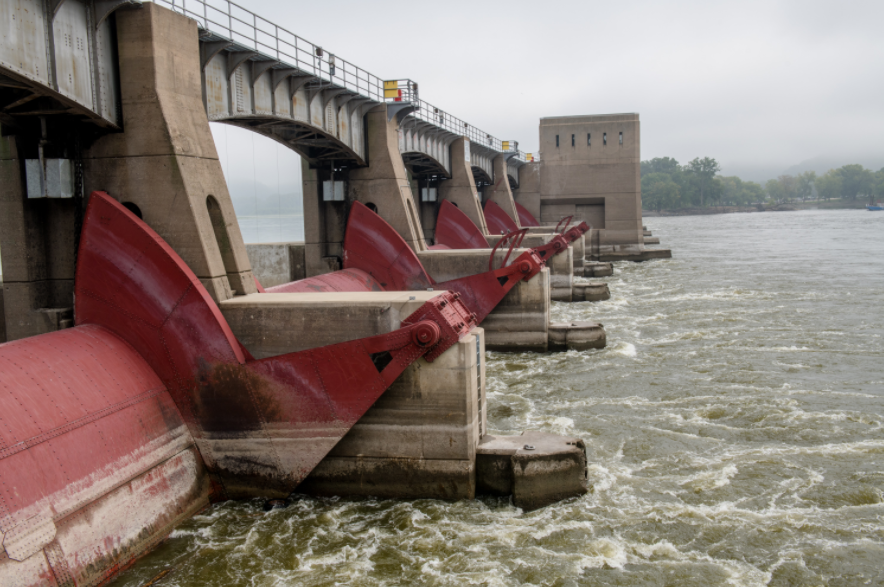
The series of locks and dams spanning the Upper Mississippi River allow for commercial traffic to navigate efficiently. (Photo Credit: Joseph L. Murphy/Iowa Soybean Association)
Iowa Soybean Farmers Commit $100,000 to Enhance Lock and Dam Infrastructure Along Upper Mississippi River
December 2, 2021 | Brock Johnston
Ankeny, Iowa — The Iowa Soybean Association (ISA) is offering $100,000 to address the initial engineering and design modifications necessary to improve the aging infrastructure of Lock and Dam #25 on the Upper Mississippi River.
Located in Winfield, Mo., Lock and Dam #25 assists in moving 200 million bushels of soybeans annually from growers in Iowa, Illinois, Minnesota, Missouri and Wisconsin downstream to the Gulf of Mexico, according to the United States Dept. of Agriculture (USDA) Agricultural Marketing Service.
ISA's contribution is part of a $1 million proposal made by state and national partners. They include the United Soybean Board, Soy Transportation Coalition (STC), Illinois Soybean Association, Iowa Corn Promotion Board, Minnesota Soybean Research and Promotion Council, and the Missouri Soybean Merchandising Council.
“Efficiently moving soybeans through the [Mississippi] river gives U.S. soy a unique advantage over competitors,” said Scot Bailey, ISA director and board advisor to the STC. “Our checkoff investment plays an important role in improving infrastructure like Lock and Dam #25. These projects ensure a strong supply chain with goods moving in both directions and ultimately impacts the success of Iowa farmers.”
The Mississippi River transports 60% of all U.S. soybean exports, meaning investments to improve existing inland waterway infrastructure remains a priority for Iowa farmers.
Like many locks and dams along the Mississippi River, Lock and Dam #25 has yet to receive funds necessary for expansion since opening in 1939. A system fault at the facility could cost soybean farmers nearly $1.6 billion according to research conducted by The Waterways Council, Inc.
If construction proceeds, Lock and Dam #25 would be the first construction project under the Navigation and Ecosystem Sustainability Program (NESP). The Congressionally-authorized program seeks to improve transportation systems on the Upper Mississippi River to reduce commercial traffic delays and restore and enhance the environment.
“Many of these critical lock and dam projects along the Upper Mississippi River region have lingered for years – perpetually waiting for the necessary funding to increase their capacity and resilience,” said STC Executive Director Mike Steenhoek. “Farmers and other stakeholders believe it is time for Lock and Dam #25 and other priority projects to finally move from the on-deck circle to the batter’s box.”
Lock and Dam #25 is not the first infrastructure project highlighted through soy checkoff investments. In 2019, checkoff contributions from soybean farmers in Iowa and throughout the country were placed into the research, design and initiation of dredging along the lower Mississippi River from 45 to 50 feet. The soy checkoff, alongside numerous partners, led the federal government and the state of Louisiana to activate $245 million for its completion.
The dredging project is estimated to create an additional $461 million in value opportunities for soybean farmers across the country, according to the STC.
“Investments should never be regarded as a one-time activity,” added Steenhoek. “They must be perpetual. Infrastructure investments that soybean farmers have made in the past have positioned us for future success. We want to continue that level of investment so U.S. soybean farmers and their consumers continue to benefit.”
###
Funded by the soybean checkoff
The Iowa Soybean Association is Driven To Deliver market demand, production research, information and insights and regulatory action benefiting Iowa's 37,000 soybean farmers and the industry. For more information, visit iasoybeans.com.
Back